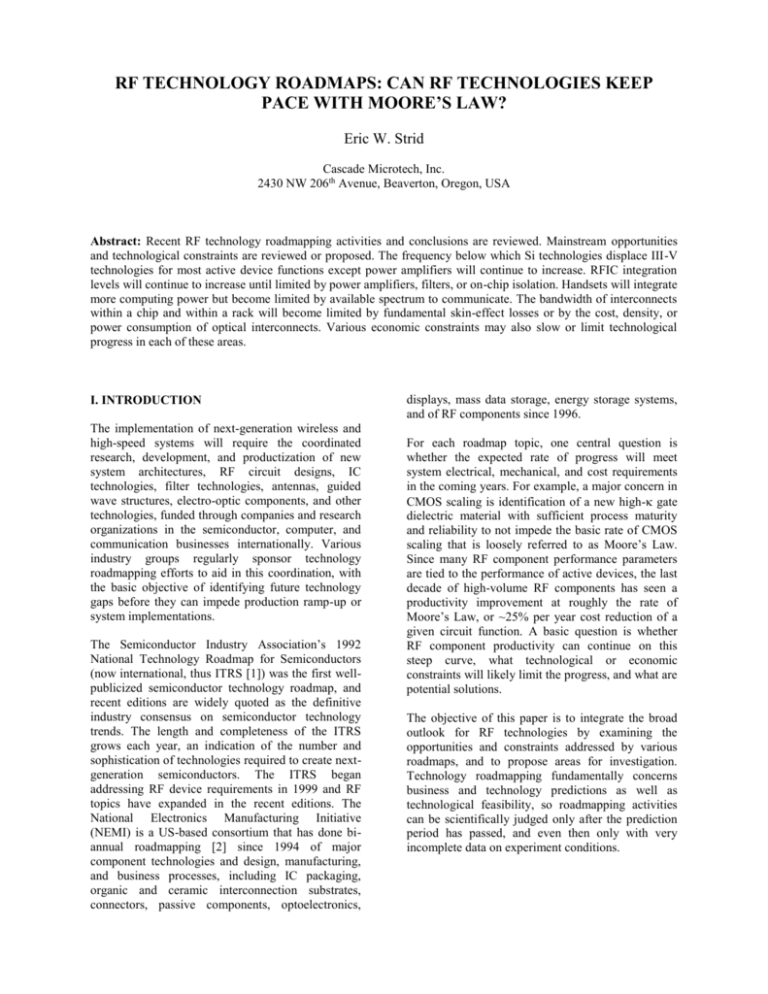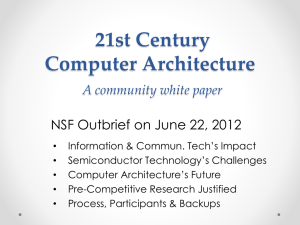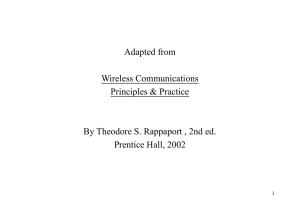rf technology roadmaps
advertisement

RF TECHNOLOGY ROADMAPS: CAN RF TECHNOLOGIES KEEP PACE WITH MOORE’S LAW? Eric W. Strid Cascade Microtech, Inc. 2430 NW 206th Avenue, Beaverton, Oregon, USA Abstract: Recent RF technology roadmapping activities and conclusions are reviewed. Mainstream opportunities and technological constraints are reviewed or proposed. The frequency below which Si technologies displace III-V technologies for most active device functions except power amplifiers will continue to increase. RFIC integration levels will continue to increase until limited by power amplifiers, filters, or on-chip isolation. Handsets will integrate more computing power but become limited by available spectrum to communicate. The bandwidth of interconnects within a chip and within a rack will become limited by fundamental skin-effect losses or by the cost, density, or power consumption of optical interconnects. Various economic constraints may also slow or limit technological progress in each of these areas. I. INTRODUCTION The implementation of next-generation wireless and high-speed systems will require the coordinated research, development, and productization of new system architectures, RF circuit designs, IC technologies, filter technologies, antennas, guided wave structures, electro-optic components, and other technologies, funded through companies and research organizations in the semiconductor, computer, and communication businesses internationally. Various industry groups regularly sponsor technology roadmapping efforts to aid in this coordination, with the basic objective of identifying future technology gaps before they can impede production ramp-up or system implementations. The Semiconductor Industry Association’s 1992 National Technology Roadmap for Semiconductors (now international, thus ITRS [1]) was the first wellpublicized semiconductor technology roadmap, and recent editions are widely quoted as the definitive industry consensus on semiconductor technology trends. The length and completeness of the ITRS grows each year, an indication of the number and sophistication of technologies required to create nextgeneration semiconductors. The ITRS began addressing RF device requirements in 1999 and RF topics have expanded in the recent editions. The National Electronics Manufacturing Initiative (NEMI) is a US-based consortium that has done biannual roadmapping [2] since 1994 of major component technologies and design, manufacturing, and business processes, including IC packaging, organic and ceramic interconnection substrates, connectors, passive components, optoelectronics, displays, mass data storage, energy storage systems, and of RF components since 1996. For each roadmap topic, one central question is whether the expected rate of progress will meet system electrical, mechanical, and cost requirements in the coming years. For example, a major concern in CMOS scaling is identification of a new high- gate dielectric material with sufficient process maturity and reliability to not impede the basic rate of CMOS scaling that is loosely referred to as Moore’s Law. Since many RF component performance parameters are tied to the performance of active devices, the last decade of high-volume RF components has seen a productivity improvement at roughly the rate of Moore’s Law, or ~25% per year cost reduction of a given circuit function. A basic question is whether RF component productivity can continue on this steep curve, what technological or economic constraints will likely limit the progress, and what are potential solutions. The objective of this paper is to integrate the broad outlook for RF technologies by examining the opportunities and constraints addressed by various roadmaps, and to propose areas for investigation. Technology roadmapping fundamentally concerns business and technology predictions as well as technological feasibility, so roadmapping activities can be scientifically judged only after the prediction period has passed, and even then only with very incomplete data on experiment conditions. II. ACTIVE HANDSETS DEVICES FOR WIRELESS While technological limitations are important, most technologies or applications can be significantly accelerated if sufficient funding is applied. For example, Si production device speeds pulled ahead of compound semiconductor devices due to the much larger development effort applied to Si, in spite of an inherent mobility disadvantage [3]. Today the development of a leading-edge CMOS logic process costs over US$500M per year and the fabrication facility cost is US$2-4B [4]. By contrast, the worldwide revenues for all GaAs producers was about US$3B in 2001. The feasibility of scaled MOS devices with dimensions of 10 nm has been shown, leading to predictions that Moore’s Law scaling will continue in CMOS until roughly 2015, after which other device types will be required [1,5]. But this scaling rate assumes that end-user demand generally continues to increase at ~9% CAGR for the industry to be able to afford the developments, and that remaining problems be solvable within the time and funding available. For RFICs, CMOS has been shown to be very applicable to all active functions in receivers and transmitters except power amplifiers up to about 10 GHz [1]. Above 40 GHz, compound semiconductors currently dominate, and from 10 to 40 GHz, a mix of Si and III-V technologies is typical. Due to the higher rate of investment in Si CMOS, these crossover frequencies will continue to rise. Power amplifier efficiencies, and thus handset talk-time, have to date been better with III-V devices than with Si devices, so the power amplifier (PA) is one circuit block that limits integration of a single-chip radio in Si. While CMOS devices are capable of very low noise figures, a low-noise amplifier (LNA) on a large, mixed-signal chip is usually instead limited by electromagnetic interference coupled from logic or other analog circuitry on the chip. As a result, many “transceivers on a chip” integrate all the active RF functions except the power amplifier and LNA, which must be in external packages. As the number of radio bands and integration expectations increase, on-chip isolation problems will delay IC developments and will limit the integration level. III. PASSIVE HANDSETS DEVICES FOR WIRELESS To continue the reduction of size and costs, the RF section for a typical handset will reach an integration limit where all of the RF and IF functions are on one CMOS IC, except for power and low-noise amplifiers that are III-V chips. The PA and LNA, band-select filters, and maybe a duplexer or transmit-receive switch will first be integrated onto a module that contains the entire RF section except the transceiver IC. Later, the transceiver chip will also be on the module to provide a full RF section in one module. In all cases, isolation of very low-level receive signals from logic noise will be a key requirement. The simplified final assembly and design for postponement advantages of a complete RF module must compete with manufacturers that are content with providing the RF integration on the main PCB. To date, the lagging infrastructure for assembly and testing of RF modules has limited adoptions, thus further deterring infrastructure investments. The physical size of RF bandpass filters and multiplexers are generally inversely proportional to the center frequency, so size reduction has implied new filter technologies. The most promising of these is film bulk acoustic resonator (FBAR) filters, which can also be printed in arrays to reduce production costs and have the potential to be integrated onto active chips someday. The tuning of filters to the desired frequency and passband shape has historically been a very manual operation, so scaling of filter test costs requires a new test paradigm. A significant difference between computer systems and wireless communication systems is that computer systems continuously compete on performance, including CPU clock speed and computational throughput. In contrast, wireless communication formats specify most of the receiver and transmitter functionality. Instead of competing on bandwidth, transmit power, or receiver noise figure, handset radio functions must compete in the marketplace only on cost, talk-time, and the number of bands. This implies that a RF component producer generally sees continuously decreasing prices and margins with few options to increase the value-added, a challenging business environment not likely to afford investments in new technology development, even for large companies. IV. BANDWIDTH FOR WIRELESS SYSTEMS Intel recently proclaimed that “The time is not far off in which all computers will communicate and all communication devices will compute.” Clearly handsets are already becoming multi-media terminals with diverse entertainment functions. Handset computation and storage expectations will exponentiate; this need will be addressed by continuously lower power consumption in logic and memory ICs, and limited only by the handset’s energy source. Handset bandwidth expectations will also exponentiate as users transmit and receive photos, music, video clips, movies, and applications, but it is unclear how enough bandwidth will become available. Standards and spectrum availability currently pace many next-generation wireless system developments, not the RF hardware capabilities. In the next decade wireless applications could blossom at frequencies up to 100 GHz, but the risks of spectrum availability or infrastructure build-out will hamper commercialization and therefore the investment necessary to develop and scale the RF technologies to lower cost and wider adoptions. One of the clear lessons of the 2000 telecomm bust is how little consumers are willing to pay for much more bandwidth. Ultimately, end-user demand will throttle the development of wider bandwidth communication hardware and services. V. INTERCONNECTION LIMITS FOR HIGHSPEED DIGITAL SYSTEMS While not a traditional “RF” technology, the interconnection requirements of high-speed digital systems will increasingly drive the performance of wideband transmission line technologies. CPU functionality has increased 1000X about every 12 years, leading some to claim that the bandwidth of CPU connections needs to increase tenfold every four years to keep up with CMOS scaling. Historically most computer busses are as wide as the data and address words and operate synchronously. As higher speeds are required, parallel busses are being replaced by multiple self-clocked serial ports, such as the PCI Express standard. These ports typically use four lines, with two differential conductors for each direction. The initial speeds will be 2.5 Gbps and then increase to 10 Gbps or higher. But copper conductors fundamentally distort and attenuate fast time-domain signals. It is well known that skin-effect losses increase as the square root of frequency. Pre-emphasis (equalization) is often used in output drivers to compensate for the frequencydependent transmission line losses due to skin effect and dielectric losses above 1 GHz. However, the larger scaling problem is that the dimensions of a mode-free TEM transmission line must be scaled in the transverse direction inversely with the maximum frequency used, to avoid distortion from multi-mode propagation. So the loss of a scaled mode-free TEM line effectively increases as the 1.5 power of its maximum useable frequency (assuming negligible dielectric losses). At 110 GHz, typical coaxial lines exhibit loss of ~0.4 dB/cm, so the bandwidth of wideband copper interconnects quickly becomes a limiting factor. Optical interconnects have been proposed as a means for achieving more bandwidth within a rack, since over 1 Tbps has been demonstrated on one fiber for long-haul telecomm systems. However the cost, size, or power consumption of these wavelength-division multiplexed systems are not applicable within a rack, where for example many inexpensive 100 Gbps connections will be required between boards. Directly-modulated sources are difficult above about 10 Gbps, fiber interfacing techniques are expensive and complicate packaging requirements, and monolithic integration of optical and electro-optic functions has yet to be proven. Within a large digital chip the interconnect problem is similar, if not more challenging [1 (Interconnect chapter)]. The on-chip delay from interconnect wiring scales in the wrong direction and dominates on-chip delays with device gate sizes smaller than about 250 nm. Using more interconnect metal layers with unscaled dimensions improves the delay performance but increases the chip cost from extra processing of more metal layers. On-chip optical interconnects using integrated waveguides have been proposed as a solution for on-chip global wiring, but feasibility of inexpensive Si-compatible integrated sources and detectors has not been shown. To minimize the effects of slow global wiring, repeatered lines and interconnect-centric architectures and design tools will likely be adopted. VI. CONCLUSIONS There are potential interconnection speed-limit roadblocks looming between wireless terminals, within a rack, and even within a chip. When considering the above RF-specific technology evolutions, a common question emerges: Can RF technologies keep up with the scaling pace of Moore’s Law? From a physics perspective, the problems keep getting harder and will likely require geometrically more investment to solve them. Viewed from the economic perspective, the fragmentation of the relatively small companies that have historically provided RF components hampers the gathering of critical mass to afford the development of some of the new technologies required. So only focused large companies or the most innovative small companies are likely to be the solution suppliers and thus the survivors in the market. Another question is what alternatives will be adopted for those cases in which an RF technology doesn’t scale as fast as Moore’s Law, in the same sense that portable energy sources haven’t scaled? How will system architectures evolve if processors are limited by interconnection bandwidth? How will wireless services evolve to supply enough bandwidth at long enough ranges? Will the RF section of a handset continue to get cheaper and cheaper, or will filters or power amplifiers ultimately set the price? Etc. Certainly these problems and the problems listed in these RF roadmaps present ample opportunities for innovative new approaches. The next decade will see many exciting new RF technologies evolve and flourish. REFERENCES [1] [2] [3] [4] [5] International Technology Roadmap for Semiconductors at http://public.itrs.net/ National Electronics Manufacturing Initiative, NEMI Technology Roadmaps, 2002 Edition, Herndon, Virginia. www.nemi.org J. R. Lineback, “IBM Claims Proof of SiGe Beating InP and GaAs Chips in Future”, Silicon Strategies, Feb. 25, 2002. B. Helms, “The Challenge of Sub-90nm Technologies”, Industry Strategy Symposium 2003 Digest, SEMI. www.semi.org/issus P. Gargini, “Silicon Nanometrics and Beyond”, Industry Strategy Symposium 2004 Digest, SEMI. www.semi.org/issus








